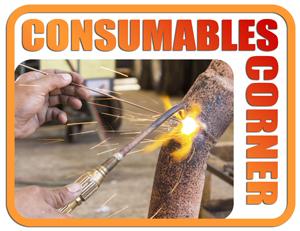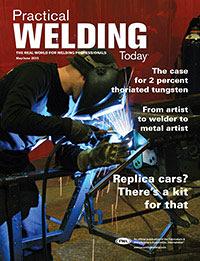Independent welding consumables professional
- FMA
- The Fabricator
- FABTECH
- Canadian Metalworking
Categories
- Additive Manufacturing
- Aluminum Welding
- Arc Welding
- Assembly and Joining
- Automation and Robotics
- Bending and Forming
- Consumables
- Cutting and Weld Prep
- Electric Vehicles
- En Español
- Finishing
- Hydroforming
- Laser Cutting
- Laser Welding
- Machining
- Manufacturing Software
- Materials Handling
- Metals/Materials
- Oxyfuel Cutting
- Plasma Cutting
- Power Tools
- Punching and Other Holemaking
- Roll Forming
- Safety
- Sawing
- Shearing
- Shop Management
- Testing and Measuring
- Tube and Pipe Fabrication
- Tube and Pipe Production
- Waterjet Cutting
Industry Directory
Webcasts
Podcasts
FAB 40
Advertise
Subscribe
Account Login
Search
Consumables Corner: Eliminating weld cracking in restrained joints on high-strength steel
- By Nino Mascalco, Rob Koltz, and Steve Sigler
- May 12, 2015
- Article
- Consumables
Q: We're a construction equipment manufacturer that is finding that our customers increasingly require more components designed and manufactured from high-strength steels such as A514 or 4130. This means we have to preheat and follow slow cooling conditions, but even then certain joints or components always seem to crack. We typically have weld cracking on root passes of joints, such as the end of a pipe welded to a base plate or with other highly constrained joints. Any suggestions on how to prevent cracking in the root pass?
A: Weld cracking is fairly common in high-strength steels (HSS). Generally speaking, the reason there are more issues with cracking on HSS is that it lacks give or flex, known as ductility. They are also susceptible to hydrogen cracking, martensite formation, and accelerated cooling rates can have detrimental effects on heat-affected-zone (HAZ) hardness values.
As you mentioned, preheating and slow cooling require more detail that will greatly influence whether you are successful at preventing cracking. The 4130 steel, depending on thickness, will probably require a preheat somewhere around 400 degrees F with a maximum interpass temperature of 700 degrees F. The A514 will require a preheat temperature of 200 to 350 degrees F based on thickness, and a maximum interpass of 400 degrees F.
Joint preparation is also important. Make sure there are no gouges, grease and contaminants, or dross remaining from the cutting or beveling operation. It’s preferable to start with a tight fit or less than a 1/16-in. root opening that is consistent throughout the joint.
Assuming the preheat, interpass, and slow cooling rates are under control, the next thing to consider is the filler metal. For these types of steels, be sure to use a low-hydrogen process and check that the product has been stored properly. The filler metal’s tensile strength should match the lowest strength steel of the components you are joining. Also, be sure you are following the manufacturer's specified welding parameters, and pay attention to voltage and electrical stick-out (ESO). Excessive ESO or voltage can increase hydrogen pickup from the atmosphere.
Since the root pass is where the cracking problems occur, make sure the bead profile is slightly convex and has a good depth-to-width ratio, ideally about 1 to 1. Centerline cracking sometimes is caused by the throat of the weld. If it is concave and shallow, it will not be able to accommodate weld shrinkage and the resulting residual stress. This is especially critical for highly constrained joints. The other extreme is having a weld bead that is very deep and narrow (for example, an excessive depth-to-width ratio), resulting in centerline cracking problems.
One more important thing to consider is bead sequencing. If the part has multiple welds, consider sequencing them differently to balance the residual stresses. If there is only one weld, as in the example of pipe to plate you mentioned, then try splitting the weld up into thirds or quarters. Using a clock face for direction, try welding from 12 to 3, 6 to 9, 6 to 3, and then 12 to 9 to attempt to balance out stresses.
About the Authors


Rob Koltz
Application Engineer
411 S. Ebenezer Rd.
Florence, 29501
636-485-2253
Steve Sigler
Application Engineer
411 S. Ebenezer Rd.
Florence, South Carolina 29501
636-485-2253
About the Publication
Related Companies
subscribe now

The Welder, formerly known as Practical Welding Today, is a showcase of the real people who make the products we use and work with every day. This magazine has served the welding community in North America well for more than 20 years.
start your free subscription- Stay connected from anywhere

Easily access valuable industry resources now with full access to the digital edition of The Fabricator.

Easily access valuable industry resources now with full access to the digital edition of The Welder.

Easily access valuable industry resources now with full access to the digital edition of The Tube and Pipe Journal.
- Podcasting
- Podcast:
- The Fabricator Podcast
- Published:
- 04/16/2024
- Running Time:
- 63:29
In this episode of The Fabricator Podcast, Caleb Chamberlain, co-founder and CEO of OSH Cut, discusses his company’s...
- Trending Articles
Sheffield Forgemasters makes global leap in welding technology

Welding student from Utah to represent the U.S. at WorldSkills 2024

Lincoln Electric announces executive appointments

Engine-driven welding machines include integrated air compressors

ESAB unveils Texas facility renovation

- Industry Events
16th Annual Safety Conference
- April 30 - May 1, 2024
- Elgin,
Pipe and Tube Conference
- May 21 - 22, 2024
- Omaha, NE
World-Class Roll Forming Workshop
- June 5 - 6, 2024
- Louisville, KY
Advanced Laser Application Workshop
- June 25 - 27, 2024
- Novi, MI



























